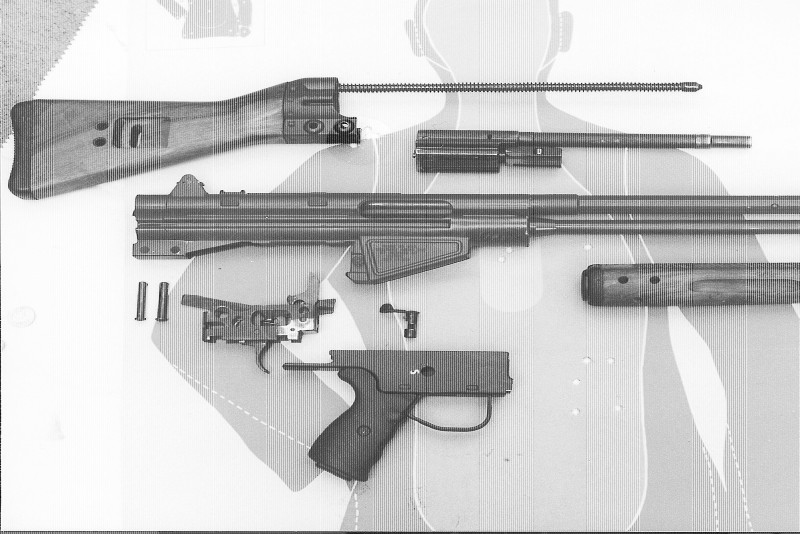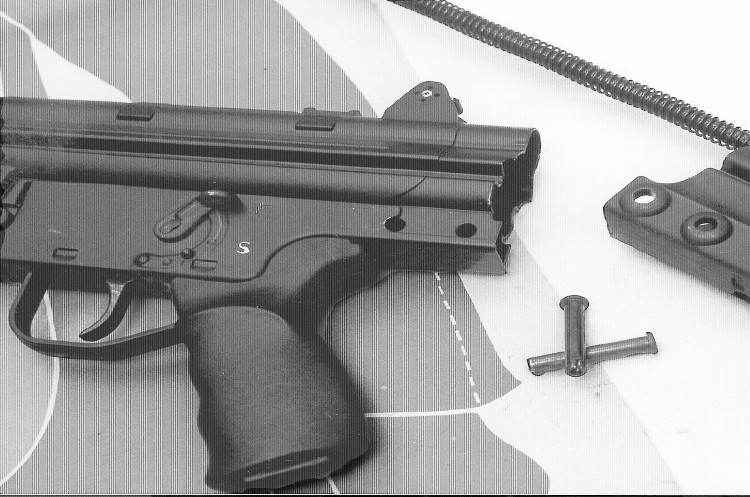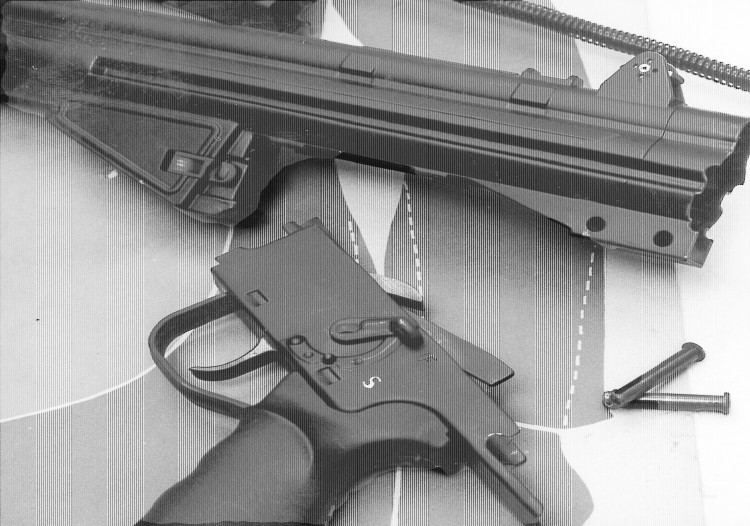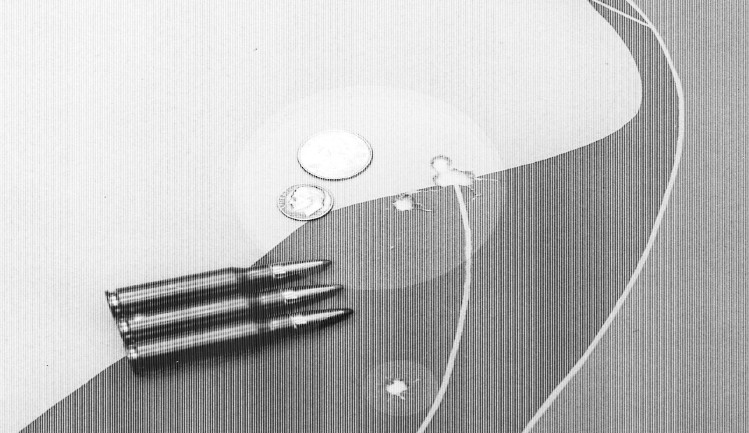CRUFFLER.COM
presents
Firearms
Technical Trivia, November 2000:
 |
A Cruffler's Illustrated
Guide to the Century CETME Sporter Rifle
by Steve
Little |
 |
The following is my experience as
the proud owner of one of the new post-ban CETME style rifles that are
currently on the market. I have never owned a Heckler & Koch
(HK) firearm, but I do have ample personal knowledge of and have fired
them on a number of occasions. They have a reputation as well designed,
well made and reliable firearms. I had a vague familiarity with CETME rifles,
but had only seen the a pre-ban CETME Model Sport at a handful of gun shows.
Actually, what I'm reasonably sure I was seeing was a single rifle that
was making rounds of the state. I have always thought the CETME to be an
aesthetically pleasing firearm due to the wood furniture. It adds a certain
warmth lacking in the typical black plastic stocked evil black rifle (EBR),
much like the M-14/M1A. I have to admit that I'm a victim of the
anti-gun propaganda that has vilified military lookalike firearms over
the last twenty years. As a result, an all plastic and metal firearm
doesn't strike many responsive chords in me. Besides, wood adds a
certain nostalgia and individuality to the rifle.
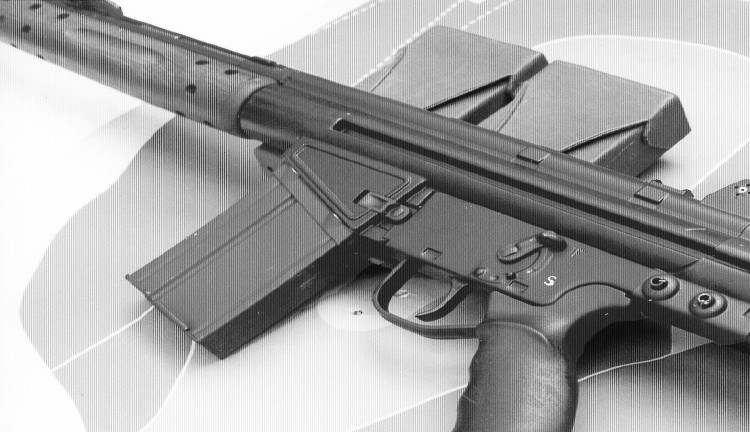
|
Based on this limited knowledge and
visceral appeal, when the CETME's hit the market I was eager to buy one.
I did not purchase from the first distributor that I noticed carrying them.
I shopped around and decided to purchase from AIM
Surplus. AIM's staff was friendly and responsive, answering any
and all questions asked. However, hindsight being 20-20, I
failed to ask about interchangeability and commonality with with HK 91
style rifles.
Upon receiving the CETME I was initially
impressed and pleased, especially since the rifle had cost many mortgage
payments less than a pre-ban HK 91. The receiver was nicely finished
in what appeared to be a black epoxy coating. This differed from
the original parkerizing finish of the butt stock metal and forearm metal.
Just to note, the magazines have the same parkerized finish. In any event,
I did not find the juxtaposition of the two finishes displeasing. The rear
sight configuration was also somewhat surprising. In the advertisement
it looked very much like the HK drum sight. (In all fairness, it
probably was the CETME style sight in the photo. If I had been just a tad
more familiar with the CETME , I would have realized what a CETME rear
sight would look like.) Overall, the rifle's appearance was quite pleasing.
The next step was to detail strip
the rifle for cleaning and inspection. (This is a must for every new gun,
especially one made from a military parts set on a new semiauto receiver.)
Among other reasons, the shooter is able to ensure that there will be no
obstructions in the bore, or significant grease build up that will affect
the rifle's functioning. The CETME came with a very liberal coating
of what look like white lithium grease on the inside of the receiver, the
bolt carrier/bolt head assembly, and including the operating/recoil spring
rod. This sort of excess lubrication can contribute to poor reliability
and an inability to properly feed, extract or eject.
Since there were no instruction or
maintenance information packed with the gun, disassembly and detail stripping
were conducted on the basis of common sense and HK 91 reference manuals.
Initially, I suspected that the two buttstock pins, might be of the
"captive" type like on AR-15/M-16 rifles. As a result, I did not
drive them fully from their seating in the gun. And they do
indeed need DRIVING. The pins were very tight and had to be removed
with a punch and mallet. CETME pins are hollow, so a punch of similar
diameter to the pins was used to ensure that the punch didn't enter the
pin. HK pins are solid and I can be removed with finger pressure alone.
HK pins will fit the CETME. Once the buttstock pins are removed, the buttstock
can be moved to the rear, off the receiver. "Moved" is probably misleading.
I found that I needed to vigorously hit the butt with the palm of my hand
to move the stock off the receiver. I did not dismantle the buttstock with
its built in buffer assembly, and thus cannot comment on whether these
components are is similar to those on an HK 91.
While we are on the subject of interchangeability,
there are several parts that were expected to interchange, but did not
as they were a bit different in design and execution. As complete assemblies,
the stock and trigger group (the trigger housing actually) appear interchangeable
with HK components. But individual parts and sub-assemblies will probably
not interchange. As an example, the trigger pack assembly appears
to be of the same dimensions but the internal parts look are quite different;
the safety, for instance, moves upward to the fire position. On the HK
it comes down to the fire position. I believe the HK version to be
much more intuitive. The hammer, trigger and sear are all of a different
geometry than those of the German gun. Out of curiosity, I phoned
Ted Williams of Willaims Set Triggers. According to Mr. Williams,
he has examined several of the CETME rifles and found the American parts
installed to ensure compliance with Section 922r of Title 18 of the US
Code to be of inferior quality. Consequently he will either decline
to work with them or not guarantee any work done on them. He suggested
that I replace the components with an HK trigger group, as he can reliably
predict the quality of these. Unfortunately this is not an option, as the
rifle would then be in violation of the Section 922r. We can only
hope that a domestic source of quality fire control parts for the CETME
arises shortly.
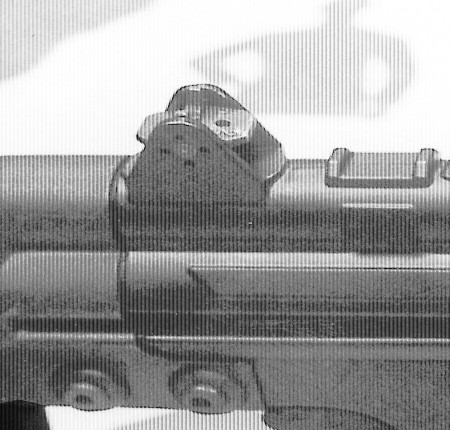
|
The rear sight
on the CETME is a lot like a paddle wheel on a toy paddle wheel boat. It
rotates on a vertical plane, each "paddle" having an aperture graduated
for a different range. The nature of the four apertures is similar to the
HK - the 100 meter battlesight is an open V notch and the balance
are circular apertures. My rifle has the distinction of a pinched
sight assembly so that the wheel does not want to go into the 400 yard
setting with finger pressure only. To remedy this, I needed to separate
or "spread" the assembly enough to loosen this up, but not so loose that
the small detent |
ball on the paddle no longer engages
the appropriate whole to hold position. The front sight is entirely dissimilar
to the HK. It is an elevation adjustable post and requires a special
spanner tool which will pass down through a hole in the top of the sight
assembly. A small set screw must be loosened first before screwing the
front sight post up or down. A unique CETME feature is the small
cleaning kit contained under the "cap" which normally forms the bayonet
attachment point for the H&K bayonet. These caps are not interchangeable.
The operating handle
| tube or cocking
tube on the H&K rifles reduces diameter just prior to the front sight
assembly. This is also where the HK rifle mounts the retaining bracket
that the forearm retaining pin fits through. Not so on the CETME.
The cocking handle tube is full diameter all the way to the sight. This
allows for the cleaning kit to fit within this space but means that the
CETME forearm attaches in a different manner. The forearm itself has a
screw that passes through from |
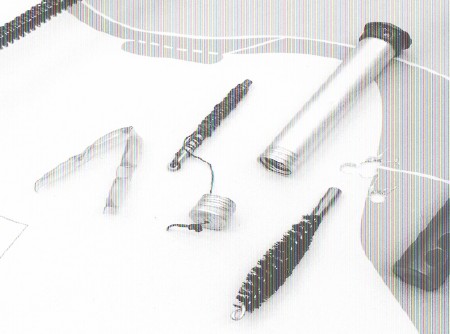
|
right to left and pinches or draws in
on a spring clip which mates to a groove provided for it on the barrel
just behind the front sight assembly.
As per US law, the rifle comes with
a muzzle brake and not a flash hider. The brake is permanently secured
with high temperature solder. The brake is quite effective, and along with
the rubber butt plate, helps to ensure that recoil is mild and firing not
unpleasant. It contains four groups of holes which bored perpendicular
to the axis of the bore. They are placed at 12, 3, 6 an 9 O' clock
respectively. I would have preferred that the holes at 6 O' clock had been
omitted so that some form of muzzle compensation would be achieved.
Surprisingly, the flash signature at dusk is not bad. As noted,
there is no flash suppressor but there is no fireball or excessive flash
when firing. The muzzle signature was minimal and did not exceed an inch
to an inch and a half radius from the bore.
The final differences between the
HK and the CETME worth noting are in the magazine assemblies. The CETME
magazines are of twenty round capacity and very easy to fill. They are
of similar construction to the HK but contain a few significant differences.
The CETME magazines have a slight curvature to the magazine bodies and
are constructed of steel with a parkerized finish that
matches that of the steel portions
of the buttstock group. The finish is rough to the touch and while I have
had no feeding problems with the CETME magazines, it has been pointed out
that H&K magazines are quite smooth on the inside - a better condition
for sure when it comes to magazines! The magazine floorplate differs
from the HK in that there is no push button retainer, only a flat plate
which must be bent slightly to slide the bottom off similar to AR-15/M-16
magazines. I was able to bend and slide the bottom off and replace
it without any discernible permanent warping of the base plate. The best
thing about these CETME magazines are that you can get an honest military
surplus, like new, pre-ban magazine for H&K style firearm for $20.00
if you purchase at least 5 at a time from AIM Surplus.
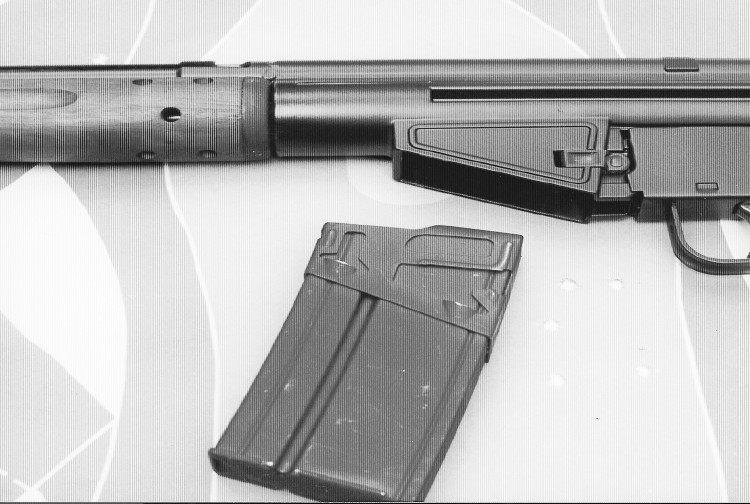
|
CETME Disassembly
The CETME is very similar to the HK
so HK reference material can be used with the CETME. After driving
out the captive pins from the buttstock and removing the buttstock as described
above, retract the cocking handle and tilt the gun muzzle upward.
This will allow the bolt carrier group to slide out the open back of the
receiver.
The trigger housing can now be removed
from the receiver by pulling down and back on the pistol grip. Rotate
the safety lever upward until the arm of the selector is straight up.
Pull the selector switch out of the trigger housing. The trigger
"pack" (which is the unitized fire control parts contained within the trigger
housing) may now be removed.
A spray cleaner and degreaser like Birchwood
Casey Gun Scrubber can be used to clean the trigger pack if you
are not the adventurous type. Be aware, further disassembly of the
trigger group will require driving out several retaining pins and
the careful notation of assembly order. This can be tricky so if
you do not have a photographic memory it is probably best left to Gun
Scrubber. As mentioned earlier, most of the parts within this
group are not interchangeable with H&K weapons on a part by part basis
for both physical and legal ones.
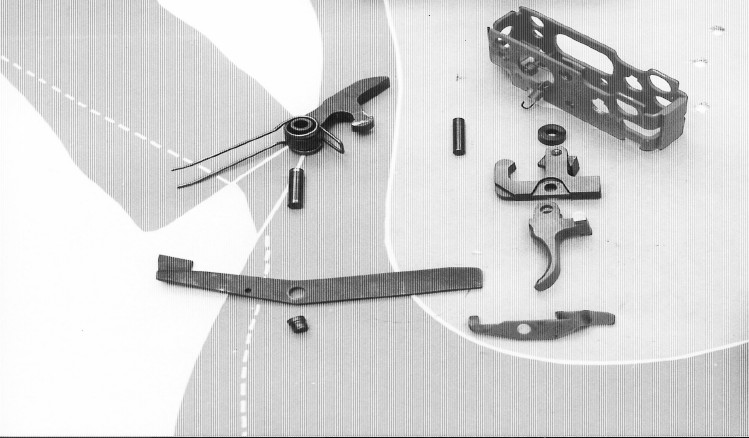
|
The forearm is removed by simply unscrewing
the screw located opposite the front sling eyelet and pulling down
on the forward portion of the forearm. My rifle required a little bit of
prying with a non-marring tool since the retaining "clip" seemed to still
have a pretty good hold on the barrel. The cleaning module or capsule may
be removed by using punches or bullet tips to simultaneously press in on
opposing spring loaded detents which are accessed on the front sight assemble
around the upper portion.
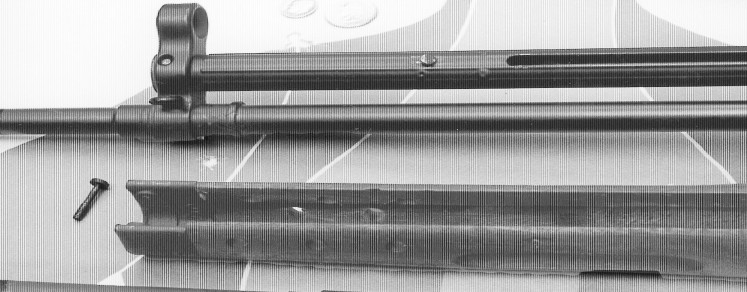
|
The bolt head and subsequent parts associated
with this assembly disassemble exactly like an HK firearm.
This is another area which can be difficult. The bolt head must rotate
counter clockwise about 90 degrees to disengage from the bolt carrier.
It then can be pulled forward out of the bolt carrier. The firing pin and
firing pin spring will be free to be removed from the bolt carrier after
the bolt head is removed. The difficult part is getting it back in place
and rotating it back under the pressure of the bolt head locking lever.
With hands that are covered solvents and lubricants at this point
is reassembly, an old T-shirt comes in handy to give some gripping
leverage. The bolt carrier itself requires no more disassembly.
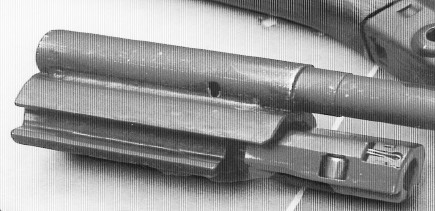
|
Assembly is
in reverse order and I found only one surprise except for one. The fit
of the trigger housing and the buttstock parts onto the American made receiver
are very snug. It took a rubber mallet to bring these parts to the point
where I could drive the stock retaining pins back into their respective
holes. But each assembly and disassembly seems to get easier. |
For a fraction of what an HK rifle
would cost now, I am more than happy with this purchase. The rifle
is capable of some outstanding accuracy, as can be seen from the 100 yard
group barely the size of a quarter, except for the first round flyer. If
there is ever an industrious American out there willing to address the
trigger quality shortcoming, I am sure this rifle could compete very favorably
with the more expensive HK 91.
HOME








